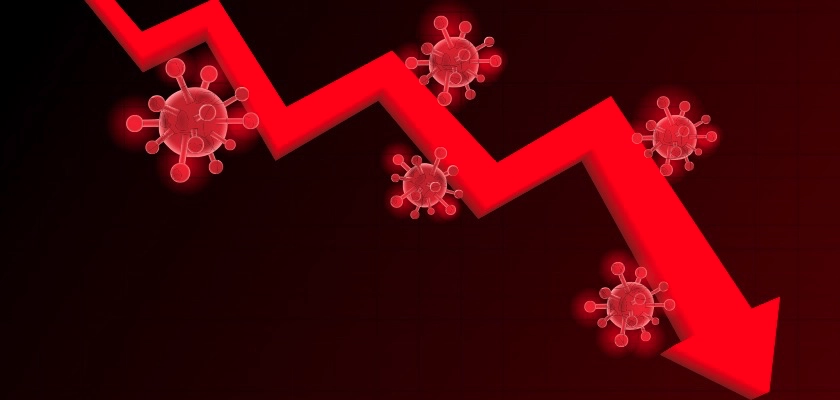Exploring the Economic Impact of the COVID-19 Recession | June 2021
The COVID-19 pandemic brought not only a health crisis but a financial one. High unemployment rates, food scarcity, and a slowed global supply chain impacted millions of families across the country.

COVID-19 upended the global economy, resulting in not only a health crisis but a financial crisis. As the United States declared COVID-19 a public health emergency in February 2020, the country entered a new recession a month before the health crisis had earned the label of “pandemic” from the World Health Organization (WHO).
The term recession refers to a decline in production, employment, and income. Though economic contraction rarely occurs as rapidly as it did in the early stages of the pandemic, the health crisis caused travel restrictions, temporary business closures, and joblessness in a short period of time. The result was unusually high unemployment, a sharp increase in savings, and a global stock market crash.
High Unemployment
Before the COVID-19 pandemic, unemployment in the United States was steady, resting below 4 percent. At its peak during the pandemic, unemployment hit 14.7 percent, the highest unemployment rate since the Great Depression. Even a year after the onset of the health crisis, unemployment remains elevated, standing at more than 6 percent.
The travel and hospitality industries were among the hardest hit, greatly impacting tourist hot spots such as Orlando and Las Vegas. These cities have high employment concentrations in hospitality and leisure, so their unemployment rates were and continue to be above-average.
High Rates of Hardship
With tens of millions of people unemployed or underemployed, many individuals are still struggling to afford food and housing expenses. Underemployed refers to individuals that are working beneath their knowledge and skill level or individuals who work part-time but would rather work full-time.
According to the U.S. Census Bureau Household Pulse Survey, 1 in 9 adults reported that their households sometimes or often do not have enough food to eat. In addition, millions of Americans are behind on rent and mortgage payments, and 27 percent of adults reported difficulty in affording usual household expenses including food, rent or mortgage, car payments, medical expenses, and student loans. Households with children are even more likely to face hardship.
Decreased Spending
The pandemic led to panic buying and stockpiling of toilet paper, canned foods, frozen foods, and other essentials. Spending on groceries increased while most other product categories, such as out-of-home entertainment, declined.
Consumer spending habits can have strong ripple effects throughout the economy. For example, metropolitan areas that rely on tourism faced higher unemployment, lower tax revenue, and lower spending than other major cities. Additionally, certain changes in consumer spending habits are likely to remain. For example, many people ordered grocery delivery and turned to online shopping for the first time during the pandemic. While many shoppers will return to brick-and-mortar, the online trend is here to stay.
Increased Saving
Overall, the pandemic shifted people’s banking habits from spending to saving, resulting in the highest level of saving since the 1980s. Despite the U.S. government’s efforts to stimulate the economy with government-issued stimulus checks, Americans continued to put most of their money into savings.
The Global Supply Chain
Early in the pandemic, panic buying and stockpiling crippled the supply chain. Suppliers attempted to ramp up production to meet the increased demand. Additionally, though food was abundant, the complex global food supply chain became dislocated. Dairy Farmers dumped millions of gallons of milk every day because large milk purchasers, such as Starbucks, no longer needed as many batches as before, yet the dairy cows still needed to be milked.
Because of the complex nature of the supply chain, products were not easily redirected to consumers. The closing of restaurants, hotels, and schools left many farmers without buyers for more than half of their crops.
Because of the global nature of the economy, many supply chains were impacted. For instance, many toy factories shut down in China where most of the world’s toys are manufactured. Manufacturers faced labor and raw material shortages, operating at a fraction of total capacity. Manufacturers experienced delays and trouble fulfilling retail orders. Other businesses
that rely on Chinese manufacturing, such as Apple, struggled. Companies that invested in mapping their supply chains prior to the crisis to identify which suppliers and parts had the potential to be at risk during a disruption were better prepared.
Even now, many supply chains are stunted. For example, a semiconductor chip shortage has slowed recovery in the auto industry, delaying vehicle production and causing a rental car shortage.
A Boost for Tech
While tourism, hospitality, and leisure were negatively impacted, the technology industry benefited in many ways. Social distancing guidelines and work-from-home orders resulted in the increased use of software for remote work, such as Zoom, Slack, G Suite, Asana, and Microsoft Teams. Many companies have committed to using remote or hybrid work models in the long run.
Additionally, many brick-and-mortar retailers turned to tech solutions such as Shopify for online sales, Uber Eats for food delivery, or Mindbody for streaming fitness classes. Increased tech spending could be a long-term trend, which will likely result in more individuals working in the industry.
A Global Economy in Recovery
The United States is not the only country experiencing a recession as a result of COVID-19. In fact, according to the BBC, most countries are now in recession. Most major economies experienced a decline in gross domestic product (GDP) in 2020 with the exception of China which grew by less than 3 percent.
Though vaccines are widely available in the United States, this is not the case for many countries. Additionally, regardless of vaccine availability and vaccination rates, the economy will not repair itself overnight. The road to recovery will be a long one with many speed bumps along the way.
In the Classroom
This article gives students a look into the recession sparked by the COVID-19 pandemic. Economic contraction, recession, and unemployment are all discussed in Chapter 1: The Dynamics of Business and Economics. This article could also be used to support Chapter 8: Managing Operations and Supply Chains and Chapter 15: Money and the Financial System.
Classroom Activity
Visit CNN Tracking America’s Recovery to view the “Back-to-Normal Index.”
- How is your state performing on the Back-to-Normal Index compared to other states?
- How does e-commerce spending in 2021 compare to 2020? 2019?
- Discuss the trends in travel including travelers at TSA checkpoints and hotel occupancy.
Discussion Questions
- What is a recession? What factors led to the COVID-19 recession?
- What industries were hit the hardest by the COVID-19 recession? Why?
- How has the COVID-19 recession impacted consumer saving and spending?
This article was developed with the support of Kelsey Reddick for and under the direction of O.C. Ferrell and Linda Ferrell.
Sources:
Brookings Institute, "Explaining the Economic Impact of COVID-19: Core Industries and the Hispanic Workforce," February 5, 2021, https://www.brookings.edu/research/explaining-the-economic-impact-of-covid-19-core-industries-and-the-hispanic-workforce
Center on Budget and Policy Priorities, "Tracking the COVID-19 Recession’s Effects on Food, Housing, and Employment Hardships," May 28, 2021, https://www.cbpp.org/research/poverty-and-inequality/tracking-the-covid-19-recessions-effects-on-food-housing-and
Lora Jones, Daniele Palumbo, and David Brown, "Coronavirus: How the Pandemic Has Changed the World Economy," BBC, January 24, 2021, https://www.bbc.com/news/business-51706225
O.C. Ferrell, Michael D. Hartline, Bryan W. Hochstein, Marketing Strategy, Cengage, 2022. p. 301–308.
Paul R. La Monica, "Americans Are Hoarding Cash: Savings Rate Hits Its Highest Level Since 1981," CNN, April 30, 2020, https://www.cnn.com/2020/04/30/investing/savings-rate-federal-reserve/index.html



